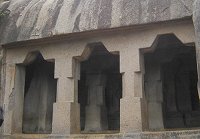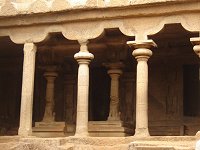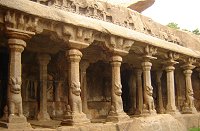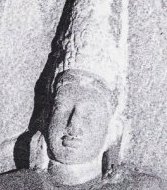Trip to Mahabalipuram on December 5, 2007
General
information pertaining to all the monuments we visited
There are
four types of monuments to be seen in Mahabalipuram - the monoliths, cave
mandapams, structural temples, bas relief.
Most of the
monuments are located slightly below the ground level. They were
once buried under the sand which had to be removed to reveal the sculptural
splendour.
The main rulers
believed to have contributed
Mahendra Pallava
Mahendra’s
son Narasimha Pallava
Narasimha’s
grandson Paramesvara Pallava
Parameswara’s
son Rajasimha
There are
four different pillars
Mahendra pillar
- square at top and bottom and octagonal in the middle
circular body
decorative
pillars with seated lion as the base
decorative
pillars with standing lion as the base.

Mahendra
pillar - square at top and bottom and octagonal
in the middle

circular
body as seen in the Mahishasuramardhini
mandapam

with seated
lion as the base as seen in Pancha
Pandavar mandapam
Both men and
women are seen wearing two different types of earrings - makara kundalam
in one ear and patra-kundala in the other, as shown in the Gangadhara panel
in the Adivaraha cave.

In the early
Pallava temples, there was no lingam or idol installed in the sanctum.
Worship was offered to the relief image on the rear wall of the sanctum.
The relief image was either in the form of stone carving on the wall or
a wooden panel. Hence, some of the mandapams now have empty garbagrihams.
There are
no inscriptions in any of the monuments indicating the ruler who was responsible
for the excavation/construction. The inscriptions available are slokas,
the king's titles... They are in Pallava Grantha script or Devanagiri.
Later Chola inscriptions are in Tamil.
Dwarapalakas
are the gate-keepers seen on either side of the garbagriham guarding the
deity. It is possible to identify if a shrine is for Siva, Vishnu,
Brahma or Durga by studying the dress, hair style and weapons of the dwarapalakas/dwarapalikas.
In the Siva shrines, they are seen with jatamakutam, in a fierce mood,
with wide eyes, holding a club or sword. In the Vishnu shrines they
have a youthful and pleasant look, with a crown on their head. In the Durga
shrines, there are female gate keepers, Dwarapalikas.
Dr.Swaminathan, retired professor from IIT Delhi had organized a
trip to Mahabalipuram to understand and appreciate better the great art
treasures gifted to us by the Pallavas.
We visited only a few mandapams and caves, but at every spot
Mr.Swaminathan shared with us details such as - the Pallava kings who
had contributed, the structural variations / refinement that can be
observed in the structures belonging to different periods. And sadly,
also the vandalism - mostly broken noses, attempt to project a Siva
temple as a Vishnu temple or vice versa and also an attempt by the kings
to take credit without contributing. Since several Pallava rulers seem
to have shared the same titles, that further adds to the confusion.
Mr.Swaminathan first gave a general introduction to the temple
architecture and sculpture - the different styles of rock architecture
seen at Mahabalipuram - the monoliths, cave mandapams, structural
temple, bas relief.
|